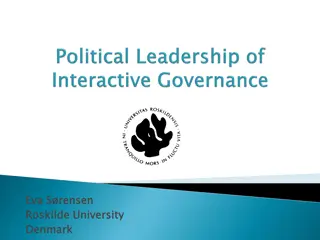Understanding Combined Assurance in Corporate Governance
Combined assurance incorporates and optimizes all assurance services to create an effective control environment, supporting decision-making processes. It involves management, governing bodies, oversight committees, and various assurance providers working together to address significant organizational risks. The different levels of assurance include extensive, moderation, and limited assurance, each with specific scopes and periods of work. Overall, it aims to provide a coordinated approach to assurance activities within the organization.
Download Presentation

Please find below an Image/Link to download the presentation.
The content on the website is provided AS IS for your information and personal use only. It may not be sold, licensed, or shared on other websites without obtaining consent from the author. Download presentation by click this link. If you encounter any issues during the download, it is possible that the publisher has removed the file from their server.
E N D
Presentation Transcript
Presentation outline Combined assurance Coordination of combined assurance Methodology of combined assurance Combined assurance committee Different role players Anticipated benefit of combined assurance Conclusion
Combined assurance King IV Combined Assurance Model is defined as one which : incorporates and optimises all assurance services and functions so that taken as a whole, these enable an effective control environment; support the integrity of information used for internal decision-making by management, the governing body and oversight committees Combined assurance is the planned approach to assess the extent and adequately of assurance coverage on key organisational risks and reporting to the audit committee and Council Combined assurance provide a coordinated approach to all assurance activities to ensure that assurance provides within the organisation adequately address significant risk facing the organisation
Combined assurance providers Management responsible for ensuring that a robust risk and control framework is in place so that deviations are identified timely and adequately addressed Internal assurance providers responsible for supporting management, such as risk management Compliance and legal services Referred to second line of defence they assist management External assurance providers AG responsible for independent external assurance (Such as Auditor General South Africa)
Different levels of assurance Extensive assurance The scope of work covers the entire process area The period covers more than half the year Positive opinion or certification is provided Moderation assurance The scope of work covers part of the organisational processes The period of work covers less than six months of period being reviewed Limited assurance statement provided Limited assurance The scope of work covers a specific part of organisational processes The period of work covers less than three (3) months of the year being reviewed No assurance statement is provided
Different role players on combined assurance Management The level of assurance required from management is extensive Specific roles Execute responsibilities as set out in the risk management strategy Empower officials to perform effectively through proper communication of responsibilities policies and procedures, delegations of authority Oversee/monitor the management of risk in their areas management review, self-assessment Provide risk management reports Maintain the proper functioning of the control environment Hold officials accountable
Different role players on combined assurance Risk Management, Anti-corruption and Anti-fraud committee The level of assurance required from the Risk Management Committee is extensive Specific roles Review and recommend approval of risk management policies, strategies, plans and risk appetite Evaluate the extent and effectiveness of integration of risk management within the municipality Assess the implementation of the risk management policy and strategy including the risk management plan Evaluate the effectiveness of the mitigating strategies implemented to address the material risks of the municipality
Different role players on combined assurance Risk Management, Anti-corruption and Anti-fraud committee Review the material findings and recommendations by assurance providers on the system of risk management and monitor the implementation of such recommendations Interact with the Audit Committee and share information relating to material risks of the municipality Provide timely and useful reports to the Municipal Manager on the state of risk management, together with accompanying recommendations to address any deficiencies identified by the Committee
Different role players on combined assurance Internal Audit The level of assurance required from Internal Audit is extensive Specific roles Provide independent objective assurance on the effectiveness of risk management recommendations for improvement Develop an audit plan based on the risks Assess whether the risk response of management is appropriate to limit risk Prepare reports
Different role players on combined assurance Council The level of assurance required from Council is moderate Specific roles Obtain assurance that properly established and functioning systems of risk management are in place Ensure that risk strategies are aligned to the mandate and objectives of the municipality Obtain assurance that risks are identified and properly managed Assist the Municipal Manager to deal with risks beyond his/her control e.g. fiscal and political risks Insist on the achievement of objectives
Different role players on combined assurance Municipal Manager The level of assurance required from the Municipal Manager is extensive Specific roles Accountable for the overall governance of risks Hold management accountable for designing, implementing and monitoring risk management Providing leadership and guidance Ensuring that an appropriate control environment including the tone at the top Ensuring appropriate action is taken in response to matters raised by the assurance providers
Different role players on combined assurance Municipal Public Accounts Committee (MPAC) The level of assurance required from MPAC is moderate Specific roles Review recommendations Ensure appropriate actions are taken to improve financial management within the municipality the municipality s Annual Report and make
Different role players on combined assurance Audit and performance committee The level of assurance required from the Audit Committee is moderate Specific roles Review and recommend actions on risk management Provide regular feedback to the Municipal Manager Ensure that audit plans address the risk profile of the municipality Evaluate the extent and effectiveness of risk management Review and recommend actions on recommendations by other assurance providers Provide timely and useful reports to address deficiencies
Combined assurance methodology Combined assurance methodology There is supposed to be a collaborated effort There is supposed to have a common view to risk Understanding of how risk are to be covered by the assurance providers Improved beyond risk-based auditing
Combined assurance committee Identify the roles of different stakeholders Identify roles that can be aligned with other stakeholders Ensure that proper reporting on coordinated efforts is done Coordinate combined efforts assurance
Anticipated combined assurance benefits (a)Efficient and effective usage of the municipal resources (b)Improved reporting to Council and other committees, including reducing the repetition of reports being reviewed by different committees (c)Comprehensive and prioritised tracking of remedial action on identified opportunities/weaknesses (d)No risk/s falls through the cracks i.e., fewer surprises and those that occur will be identified sooner (e)No risk will be over controlled/over audited leading to cost of control being excessive improvement
Anticipated combined assurance benefits (f) Prevention of audit fatigue (g)Assurance providers will remain focused on identifying and mitigating risks talking to one another (h)Provision of considerable potential to improve risk governance thus avoiding vacuums being created and unintended consequences (i)Enhanced internal control assessments (j)Managers to become more responsive, flexible and more proactive (k)A co-ordinated effort when identifying and mitigating risks (l)The public to have a better view of the municipality
Conclusion Combined assurance should be part of our daily lives as it assist to prevent audit encourages all assurance providers to get involvedin activities fatigue and assurance























